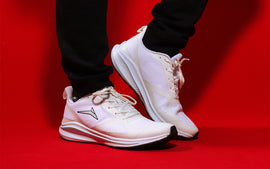Published by
India's Shoemaking Legacy: A Kaleidoscope of Tradition
India, a land known for its diverse cultures and rich heritage, boasts an extraordinary legacy in the art of shoemaking. This tradition, deeply intertwined with the country's history, reflects a kaleidoscope of cultural influences, regional specialties, and artisanal craftsmanship. From the ornate juttis of Rajasthan to the sturdy kolhapuris of Maharashtra, India's shoemaking tradition is a testament to the country's artistic prowess and enduring heritage.
1. Historical Roots of Indian Shoemaking
The history of shoemaking in India dates back thousands of years, with evidence of early footwear found in archaeological excavations from the Indus Valley Civilization. Ancient scriptures and epics like the Ramayana and Mahabharata mention various types of footwear, indicating their significance in daily life and social status. Over the centuries, the craft evolved, absorbing influences from various dynasties and empires, including the Mauryas, Guptas, Mughals, and the British colonial period.
2. Regional Diversity and Craftsmanship
India's shoemaking tradition is characterized by its regional diversity, with each state offering unique styles and techniques. Here are some notable examples:
1. **Juttis from Punjab and Rajasthan**
Juttis are traditional North Indian footwear, known for their intricate embroidery and vibrant colors. Made from leather, these shoes often feature delicate designs using threads of gold and silver. They are a staple at weddings and festive occasions, symbolizing the rich cultural heritage of the region.
2. **Kolhapuris from Maharashtra**
Kolhapuri chappals, originating from the town of Kolhapur in Maharashtra, are renowned for their durability and comfort. These handcrafted leather sandals, with their distinctive open-toe design, are made using traditional techniques passed down through generations. They are a perfect blend of style and practicality, suitable for everyday wear.
3. **Mojaris from Rajasthan and Uttar Pradesh**
Mojaris, similar to juttis, are another form of traditional Indian footwear known for their pointed toes and intricate designs. These shoes often feature beadwork, zari embroidery, and other embellishments. Mojaris are popular among both men and women and are often worn during cultural festivities and religious ceremonies.
4. **Padukas from Various Regions**
Padukas, the oldest form of Indian footwear, are wooden sandals traditionally worn by ascetics and saints. These simple yet elegant shoes are crafted from a single piece of wood and often feature minimalistic designs. Padukas hold a significant place in Indian mythology and are considered symbols of spiritual journey and renunciation.
4 The Artisans Behind the Craft
The heart of India's shoemaking legacy lies in its skilled artisans, who have honed their craft over generations. These craftsmen, often belonging to specific communities or guilds, use traditional methods and tools to create footwear that is both beautiful and durable. The process involves meticulous handwork, from tanning and cutting the leather to stitching and embellishing the final product.
Despite the challenges posed by industrialization and mass production, many artisans continue to preserve their ancestral techniques, keeping the tradition alive. Organizations and cooperatives are also playing a crucial role in supporting these craftsmen, providing them with training, resources, and market access to sustain their livelihoods.
5 The Modern Revival of Traditional Footwear
In recent years, there has been a resurgence of interest in traditional Indian footwear, both within the country and globally. Fashion designers and brands are incorporating traditional elements into contemporary designs, creating a fusion of old and new. This revival is not only helping to preserve India's shoemaking heritage but also providing artisans with new opportunities to showcase their skills.
Moreover, the growing awareness of sustainable and ethical fashion has led to a preference for handmade, locally sourced products. Traditional Indian footwear, with its emphasis on natural materials and craftsmanship, aligns perfectly with these values, making it a popular choice among conscious consumers.
Conclusion
India's shoemaking legacy is a vibrant tapestry of history, culture, and artistry. Each pair of handcrafted shoes tells a story of tradition, skill, and creativity, reflecting the rich heritage of the region it comes from. As the world embraces sustainable and culturally rich fashion, India's traditional footwear stands out as a symbol of timeless elegance and artisanal excellence. By supporting and celebrating this heritage, we can ensure that the art of shoemaking continues to thrive, passing down its legacy to future generations.






